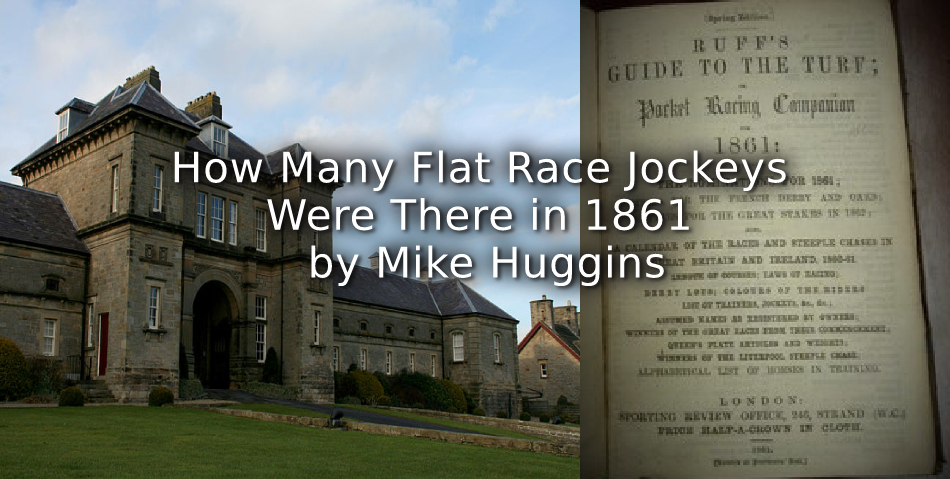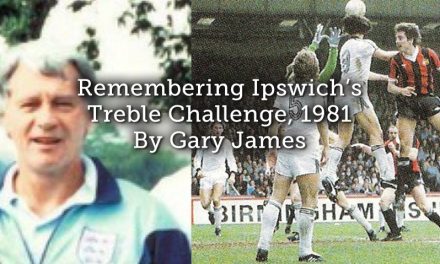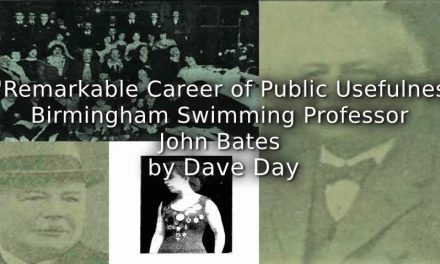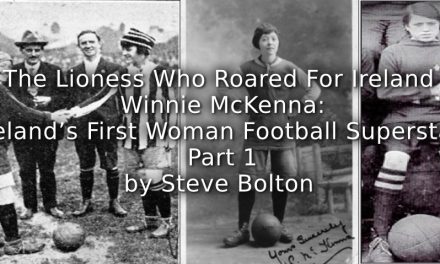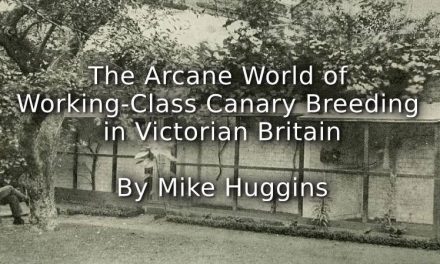Some time ago I was asked by a racing friend who saw me as an expert on racing’s history, if I knew how many flat- racing jockeys there were in the decades before jockeys were licenced by the Jockey Club. To be honest I could only give a fairly general answer. Wray Vamplew, an academic scholar who wrote The Turf back in 1976, and who more years than I care to remember ago had taught a course I took on statistical methods, and first introduced me to racing’s history, has always argued for the importance of quantification. So, I wondered, merely out of intellectual curiosity, if I could actually establish a figure for any one year? It made sense to pick a census year, so I picked 1861.
It sounded an easy task. As ever, once I thought about it, complication set in.
- Should I focus on all reported races?
- Flat races and steeplechases?
- Should I include ‘gentlemen’ riders (those described with various titles, Mr or Esquire) or just the more supposedly professional riders with just surnames or surnames and initial?
- Should I focus just on English flat racing or include Welsh and Scottish racing as well? I was not sure initially. There were lots of local races at that time unrecognised by the Jockey Club, so I thought it best to exclude them.
Eventually I decided to begin with the Racing Calendar, and focus as far as I could on flat race professionals. There were relatively few races in Scotland and Wales so I initially included them. In terms of other sources, I searched across the period from the end of the racing season in 1860 through to the end of 1861 as my data base.
Source 1: The Racing Calendar
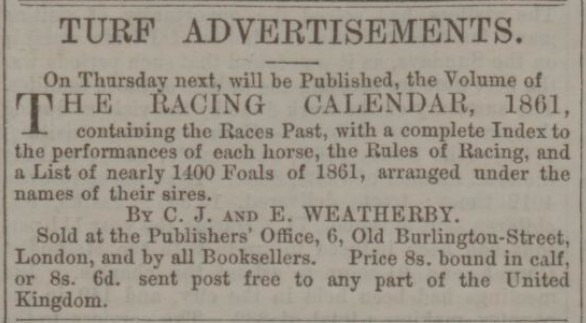
Yorkshire Gazette – Saturday 07 December 1861 Page 10
Source: BNA
The racing recognised by the Jockey Club was all listed in Charles and James Weatherby’s Racing Calendar (London, 1861). Easy I thought. The simplest way would be to open it and carefully compile an alphabetical list of all jockeys who rode. But there were almost 1400 races, and some races could have over twenty jockeys riding. So going through the entire calendar for one year did not take minutes, or even a few hours, but a long time. And when I had finished, my eyes were out on stalks and I did not want to check it. What if there were errors?
The annual Racing Calendar which gave results of the more important race meetings in Britain, was first published by Weatherby in the 1770s but even early in the 1820s the Racing Calendar’s results of each meeting listed horses, owners, placings weights carried and other details, but usually only the name of the jockey riding the winner. This changed slowly, and increasingly Weatherby’s Racing Calendar contained names of nearly all riders.
A problem soon emerged. In 1861 the Calendar usually listed all the jockey who had ridden, but many names were still surnames. Initials were rare. It meant that the same jockey’s name might have been spelt differently at different races, or that several jockeys might have had the same surname. This made accurate identification sometimes problematic, making the data quite heavily compromised.
Source 2: the Census Enumerators’ Returns
The 1861 Census was taken on the night of Sunday 7th April 1861, intended to cover all in a particular dwelling that night, and so the 1861 Census enumerators’ returns offered another way of looking at jockeys. Its occupational data could be searched. It was unlikely to cover many ‘jockeys’, since young ‘stable boys’ were often also put up because of their light weight. Maybe it would identify a core group? Having published some work myself on the census, I knew the occupational column of the returns should offer some possibility of identifying those individuals who had been perceived by household heads as primarily ‘jockeys’ when filling in the initial forms. The census has been viewed as pretty reliable. Despite P.M. Tillott’s (1972) exploration of the many sources of potential inaccuracy in the 1851 and 1861 books, he also pointed out much of the data was unambiguous and that many ambiguities were trivial and easily remedied. The on-line site findmypast perhaps offered a way of searching for jockeys in the 1861 census by inserting ‘jockey’ as a keyword in the Census category for 1861. This listed 1479 results for England alone, eight for Wales and 5 for Scotland.
Triumph was short-lived. As I started to go through the data, I quickly discovered that the list that emerged included many inns and public houses (the ‘Horse and Jockey’) and many addresses such as ‘Jockey Road’ with ‘Jockey’ in the title. Moreover, in some training stables, such as Edward Gill’s Belleisle in Richmond, Yorkshire, John Forbert’s at Spigot Lodge, Middleham, or Henry Goater in Littleton, Winchester, all stable staff were described as ‘jockey boys’. In other training stables some were clearly jockeys and others were variously grooms, assistants, stable grooms, helpers, stable boys or lads. In John Coates’ stable at Lord Zetland’s Aske Hall, Yorkshire, all his staff were supposedly jockeys.
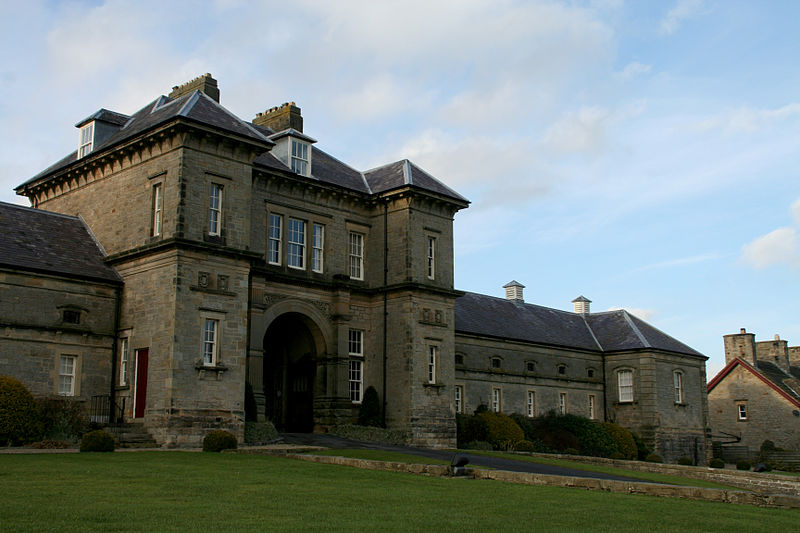
Aske Hall Old Stables: now a commercial unit housing small businesses.
Edward Nicholl, CC BY 2.0 <https://creativecommons.org/licenses/by/2.0>, via Wikimedia Commons
The transcripts provided by the site were not always accurate and had to be checked against the original record. At Malton, George Harrison was called George Houson. One horse trainer was described as a ‘nurse trainer’. One horse-breaker was called a ‘house broker’. Not all jockeys may have been involved in racing. John Mortimer, staying at the Stag Inn, Pembroke, turned out to be a circus jockey.
Currently, only 122 English jockeys have been located from the census using findmypast.co.uk by searching for ‘jockeys’, or exploiting other nominal data to locate jockeys. Clearly the vast majority of those who rode were being described in other ways, as other forms of stable staff. It has proved possible to locate with certainty only a few of these, because of the general lack of forenames in the sources.
How old were they? Jockeyship was very much a young man’s game. Joseph Shaw, in James Dover’s Cannock Chase, Hednesford stables, was only ten years old. Over two-thirds (69 per cent) were between eleven and twenty-one years old. 25 per cent more were between twenty-two and thirty-one years old.
Where did they live? The vast majority of those currently identifiable were actually living in training stables on census day, with clusterings in North Yorkshire, Newmarket, the south Downs and Berkshire. Others were ‘boarders’ or ‘lodgers’. Thomas Aldcroft, winner of the Derby in 1853, and first choice jockey for Lord Glasgow, was boarding with former jockey Tommy Lye in Middleham. William Boyce aged 42, and described as married, who could still win 4 races in 1861, was living singly as a boarder at the Wool Pack Inn, Doncaster. Thomas Johnson aged 30 was living in a lodging house in Ledbury with 22 other lodgers, almost all labourers or hawkers. Whether he was the T. Johnson who won two races that year is unclear. Some lived with relatives. William Atkinson, aged 24, who did not win a single race that year, was living with his sister and her husband at Malton.
It was usually only the older and more successful who were married and living with their family. John Charlton, aged 33, a former Derby and Oaks winner, who won 20 races in 1861 despite suffering from consumption, lived at Malton with wife, relations and two servants. Sam Roger was a jockey and trainer and in his stable at Lowther House Newmarket were four servants, no jockeys but a mixture of ‘stable lads’ and ‘stable labourers’, of very similar ages. The actual distinction was unclear. John Wells, aged 26, champion jockey in 1853 and 1854 was living in Newmarket with his wife and two servants. A very few were ‘visitors’. Henry Custance, for example, aged 19, lightweight winner of the 1860 Derby despite having to ride with twenty-two pounds of lead to make the weight, born in Peterborough, was visiting a Peterborough grazier on census night.
One puzzle was my failure to locate George Fordham, the champion jockey of 1861. He was racing at Northampton and then Croxton Park the previous week. He raced at Epsom on the Thursday after the census day. Was he enumerated? If so where? Nearly all the George Fordhams listed in the census were agricultural labourers and none was born in 1837 as the jockeypedia,co.uk site says. One possible identification was a George Fordham, ‘gentleman’, listed as a boarder at the Old Ship Hotel in Brighton, but he was recorded as aged twenty-one and from Essex. The area had seen Fordham’s early riding successes however.
Ruff’s Guide to the Turf
William Ruff, the turf correspondent of Bell’s Life first published his Ruff’s Guide to the Turf (London) in 1842 and by the 1850s the spring edition contained an ‘Alphabetical List of the Jockeys, their Addresses, Lowest Weights, Names of their Masters…’. At the beginning of 1861 it listed 130 trainers and 124 jockeys, and all but four were supposedly ‘articled’ to a stable. The term ‘articled’ was ambiguous -meaning either attached in some way to a stable, or apprenticed to a stable. Some of these names could be tracked on the on-line census, and various trainers’ enumerators returns listing their staff added more. Some newspapers covering racing in more detail also provided lists of jockeys, their addresses, masters and lowest riding weight. The Sporting Life, for example, on December 22, 1860 gave 84 jockeys.
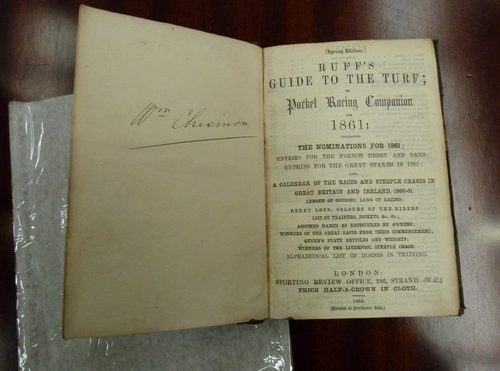
Image from online catalogue of Thomson Roddick Auctioneers & Valuers
Merging total data available thus with Ruff’s material provided a list of 199 ‘jockeys’. Most were very young, and where identifiable often still described in the census as stable boys or similar. But the list also included leading jockeys such as George Fordham, John Wells, James Goater and Harry Grimshaw. Their weights showed the importance of light weight in jockeys. Seventy of them weighed less than five stones, forty-eight more less than six stones, twenty-seven more less than seven stones, and thirty-five less than eight stones. Only nineteen of those listed, the supposed ‘heavyweights’, weighed eight stones or more.
Their location was interesting. The list was dominated by trainers from certain key areas, and it was clear that trainers’ sons who were good riders could become jockeys. Newmarket was certainly a key jockey centre. But the limestone hills around the Cotswolds (Gloucestershire, Wiltshire, Berkshire etc), such as Lambourn, Ilsley, Compton, or Wantage, was another. Others included: in North Yorkshire, Richmond and Middleham; in Sussex, Findon, Lewes, Michel Grove; in the south Epsom, Stockbridge and Kingsclere; on Cannock Chase, Hednesford. I tracked down a wide range of race horse trainers from a list I had compiled from the research for my book Flat Racing and British Society 1790-1914 (London, 2000). It was clear that some of the trainers listed in Ruff’s Guide and elsewhere at that time, such as Ascot, Tarporley Beverley or Aintree, did not advertise their jockeys. Was this due to cost?
The Press
The press offered a final source of information. The most useful source, outside my happenchance surveying, were the newspapers’ occasional comparative lists of jockeys for the interest of their readers. This may have been heavily reliant on the Racing Calendar, and so merged data from some jockeys with the same surname. Assembler error can also have crept in because immensely time-consuming. The Era, 25 November 1860, listed 252 winners of races and steeplechases in the United Kingdom but unfortunately did not distinguish between them. The York Herald listed the top twenty-nine winning jockeys of the past five years on 1st December 1860. The Sporting Life listed the thirty-three winning jockeys of the past five years on the 27 Nov 1861. The Sporting Life, 23 Nov. 1861 listed 190 jockeys from England, Scotland and Wales that had won at least one race that season so far. This was a useful data set. It showed yet again how dominant the leading jockeys were. Twenty-one jockeys had won twenty or more races, thirteen had won between ten and nineteen, seventy had won between two and nine races, and eight-six had won only a single race. Unfortunately, these lists often contained many jockeys with only surnames and no other details.
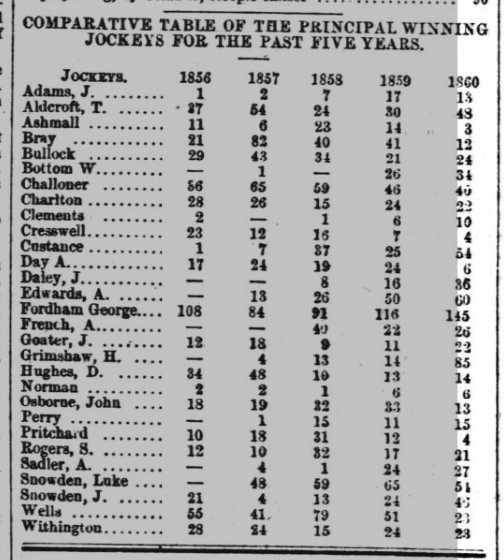
York Herald – Saturday 01 December 1860 Page 12
Source BNA
Conclusion
The number of jockeys listed in some way during 1861 is therefore still unclear. Currently my list contains 369 jockeys. Given the time this took, I suspect I have made some transcription errors. Some further jockeys may be still undiscovered. I will still have missed some, but there is an important further caveat. There was a significant proportion of examples where several jockeys shared surnames, but reportedly had different initials. The extent of journalistic reporting error is unclear. Some may have been sons of jockeys, and others, the brothers of jockeys. Currently there are 31 examples where two jockeys shared the same surname. 6 examples where three shared a surname, and Adams, Broderick, Fordham, French, and Harrison had four sharing a surname.
Article © Mike Huggins

